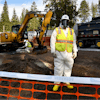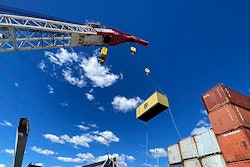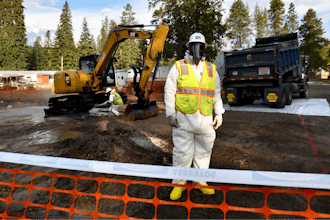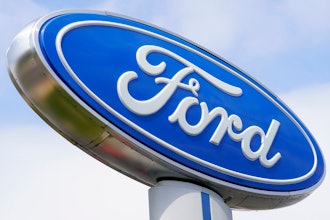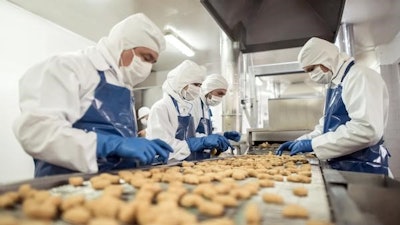
Consumers rarely appreciate the sacrifices made by workers to process their favorite snacks. In bottling plants, canning plants, and other food processing facilities, noise contributes to demanding work environments. Such was the case of a nut processor in in Northern California.
Strain Farming Company grows, harvests and shells a variety of nuts including pistachios, almonds and walnuts. The walnut hulling process specifically has a lot of moving parts that take place in Strain’s large processing facility where hearing protection is a requirement. “It’s an area where, if you are not wearing protection, you’ll lose your hearing,” explained Derick Strain of Strain Farming Company. “At first, we just had everyone wearing earplugs, but they had no way to communicate other than hand signals or yelling at the top of their lungs, which even then we really couldn’t hear each other.”
In addition to protecting his workers’ hearing, Strain needed to improve communication practices in the process. Workers would leave the building in order to have conversations, which was not productive activity. In addition, he saw the need to communicate with work teams receiving deliveries.
“We’re always talking back and forth, there are trucks coming in and out with product all the time, so communication is everything to be able to keep track. We also have to compartmentalize different lots for different growers, so we have communication needs inside and outside,” explained Strain. To complicate things, to communicate with outside parties the solution needed the ability to incorporate mobile phones.
Strain began researching communication solutions that could be integrated with PPE. He researched a variety of options and encountered high price points, complex systems and a range of unnecessary features. When Strain consulted with his team members, one of his workers recommended wireless headsets from Sena Industrial.
“I saw that they had a variety of products and one of their new lines at the time was Tufftalk M, which had the mesh capability, and that’s what we bought.” said Strain. “It was a timely arrival as well, just in time for the year’s harvest.”
Strain invested in the over-the-head Tufftalk M headset which offers mesh network communication and advanced noise control with a noise reduction rating of -26dB under ANSI S3.19-1974. The 26-decibel noise attenuation was stronger hearing protection than other models that Strain had researched, and, while he liked the protection, he wanted to focus on communication.
“Being able to use the phone while multitasking around noise was a must for me.” Phone connectivity offered with the mesh network offered that capability for Strain, easing the ability for his team to be able to communicate operations outside of the building as well as inside the building to streamline and sync up processes. “Rather than having to physically see somebody or walk outside, they could just talk. Before there was unused or wasted energy from going in and out of buildings as well as having to basically learn sign language.”
The headsets use Sena's proprietary Mesh Intercom protocol. The topology of a mesh network is made of nodes that link to each other to route data or signals. Each device on the network acts as a node, boosting the signal and extending the range of the network. The range between two Sena Mesh devices is 0.7 miles in open air, but the relay capability of devices greatly expands coverage across a job site.
Mesh Intercom technology allows a virtually limitless number of headsets, enabling their use for large and multiple work teams, who can speak on different channels. The network is self-healing: if a worker leaves the coverage area, the headset automatically reconnects to the network upon their return.
Because the processing facility is extremely large and is constructed with a lot of steel, they chose to strengthen the headsets’ mesh network with adapters. The Sena MeshPort Blue adapters were placed strategically throughout the facility to enhance the mesh network and improve communication. “We got the adapters for repeatability around the building, we also have a couple of workers in the office who are not around noise, but I still wanted to have communication with them. We got them headsets that connect to the adapters,” added Strain. “It made a pretty big difference. Once we planned out where to put the adapters, it worked great.”
“It’s a pretty big plant, so if somebody has to walk 100 or 150 feet to be able to make eye contact with someone and get on the same page it takes time. Often there are questions and other things that need said. That gets tricky," commented Strain. "There are not enough hand signals to be able to communicate everything you want to in order to do the job. With the headsets, we were able to get each job done to our specific requirements."
Strain’s team members are able to listen to music through their headsets while they work or use their phones through the headsets without interruption from background noises. “I had everyone learn how to mute the microphone, so it’s silent when we aren’t talking,” Strain said. The addition of mesh communications technology to the Strain Farming Company’s nut processing plant has improved communication and boosted productivity while protecting worker hearing at the same time.
Chris Clarke is an Industrial Communications Consultant at Sena Industrial. To learn more about Sena communication solutions, visit senaindustrial.com.
